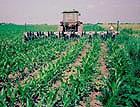What to do in the garden in mid September
Harvesting hazelnuts, cleaning up the greenhouse and mowing the meadow are all on the to-do list this week


Hazelnuts harvest
Hazelnuts are beginning to show and will be ready to harvest at the end of the month. We have hazel hedges to make the ‘walls’ between the ‘rooms’ in the kitchen garden, and the nuts are secondary, but we do get some, in spite of the winter pruning. The summer pruning ‘brutting’ or the breaking of strong laterals by hand should be done in August. This is too untidy for us, so we prune in February when the catkins start to release their pollen, but still treat each branch as a cordon. When you order the young trees, get a mix of cobnuts and filberts to help pollination.
Greenhouse clean-up
Your greenhouse may be nearly empty of stock at this time of year and so it’s a good moment to have a thorough clean both inside and out. Depending on its structural materials, using old-fashioned soap and water is often the best and easiest way to wash down the glass and framework certainly, if you still have some large plants inside that you can’t move. For modern, aluminium frames, a pressure-washer is useful to remove any pests sheltering in the nooks and crannies. And don’t forget your benches, too, as such pests as adult vine weevils hide in the corners.
Tender perennials
For propagation, your pots and trays must be clean the same goes for the growing medium. We prefer a two-to-one mix of fine Irish moss peat and coarse grit; it’s more successful than peat-free bark composts, but if you use plug trays, you’ll use very little peat. Winter isn’t always kind to tender peren-nials, and it’s sometimes better to start with new ones every year. Take softwood cuttings of penstemons now, being sure to take only the best stems. They should be about 2in long and without any flower buds. The next stage is easiest with a mist propagator, as the moisture stops the cuttings drying out, but, otherwise, you can try putting plastic bags over the cuttings in a shady corner of your greenhouse. Osteospermums, Erigeron Charity and double blue Scabious are all worth propagating and root easily, but you should be careful to take only non-flowering, basal cuttings.
Mow the meadow
Sign up for the Country Life Newsletter
Exquisite houses, the beauty of Nature, and how to get the most from your life, straight to your inbox.
No matter the size of your garden, it can benefit from an area of wild flowers that will attract friendly insects. We have about a third of an acre the other side of the kitchen garden wall that starts flowering in the spring with cowslips and tails off about now with wild geraniums, knapweed and mallow. When the last flowers have gone, we mow, turn and dry the hay, which is then stacked for feeding to the park’s Lincoln Red cattle in October. (Turning the hay in situ shakes out most of the seeds of the wildflowers for next year’s germination.) We then top the whole area with a mower to keep the rough grass short for the remaining growing season.
Philip Maddison is head gardener of Harrington Hall, Lincolnshire (www.harringtonhallgardens.co.uk)
Country Life is unlike any other magazine: the only glossy weekly on the newsstand and the only magazine that has been guest-edited by HRH The King not once, but twice. It is a celebration of modern rural life and all its diverse joys and pleasures — that was first published in Queen Victoria's Diamond Jubilee year. Our eclectic mixture of witty and informative content — from the most up-to-date property news and commentary and a coveted glimpse inside some of the UK's best houses and gardens, to gardening, the arts and interior design, written by experts in their field — still cannot be found in print or online, anywhere else.
-
 About time: The fastest and slowest moving housing markets revealed
About time: The fastest and slowest moving housing markets revealedNew research by Zoopla has shown where it's easy to sell and where it will take quite a while to find a buyer.
By Annabel Dixon
-
 Betty is the first dog to scale all of Scotland’s hundreds of mountains and hills
Betty is the first dog to scale all of Scotland’s hundreds of mountains and hillsFewer than 100 people have ever completed Betty's ‘full house’ of Scottish summits — and she was fuelled by more than 800 hard boiled eggs.
By Annunciata Elwes